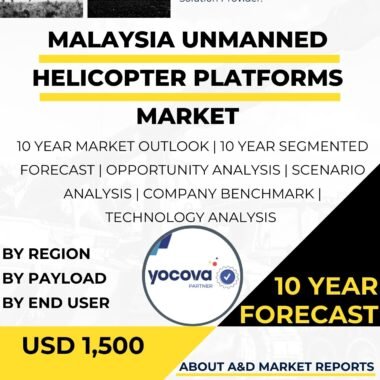Description
The unmanned helicopter platforms market in Japan has experienced significant growth and strategic importance as the nation seeks to enhance its military capabilities, bolster disaster response efforts, and address emerging security challenges. Unmanned helicopter platforms, also known as unmanned aerial vehicles (UAVs) or drones, are versatile and agile aerial systems that offer Japan a wide range of applications, including reconnaissance, surveillance, cargo delivery, and search and rescue missions.
The unmanned helicopter platforms market in Japan encompasses a diverse range of UAV types, including fixed-wing drones and rotary-wing drones (helicopters). These unmanned systems are utilized by the Japan Self-Defense Forces (JSDF), government agencies, and private enterprises to support various missions and operational requirements.
One of the primary applications of unmanned helicopter platforms in Japan is in enhancing intelligence, surveillance, and reconnaissance (ISR) capabilities. Rotary-wing drones equipped with high-resolution cameras and advanced sensors provide real-time video feeds and imagery, enabling JSDF and other agencies to gather critical information and enhance situational awareness.
Moreover, unmanned helicopters play a crucial role in disaster response and humanitarian missions. These platforms are deployed to deliver emergency supplies, medical equipment, and rescue personnel to affected areas during natural disasters and emergencies, enhancing Japan’s disaster preparedness and response capabilities.
Furthermore, the unmanned helicopter platforms market in Japan contributes significantly to Japan’s defense and security posture. Fixed-wing drones equipped with advanced sensors and communication systems are utilized for border surveillance, maritime domain awareness, and monitoring of remote and challenging terrains.
As Japan emphasizes indigenous defense capabilities, the domestic production and development of unmanned helicopter platforms have seen substantial growth. Collaborations between the government, defense industry, and research institutions have fostered innovation, leading to the creation of state-of-the-art UAVs tailored to Japan’s specific operational requirements.
Japan’s alliance with the United States has also played a significant role in the development of its unmanned helicopter capabilities. Through this partnership, Japan has access to advanced drone technologies, expertise, and support, contributing to the modernization of its defense forces and enhancing interoperability with allied forces.
The unmanned helicopter platforms market in Japan also benefits from advancements in drone technology, propulsion systems, and communication capabilities. Manufacturers have leveraged these developments to create unmanned helicopter platforms with improved endurance, payload capacity, and communication range, making them more effective and adaptable for various missions.
However, the unmanned helicopter platforms market in Japan also faces challenges related to airspace regulations, public perception, and technology integration. Ensuring the safe integration of UAVs into civilian airspace is a priority for the Japanese government and aviation authorities, requiring robust systems for air traffic management and collision avoidance.
Moreover, addressing public concerns about privacy and security is essential for the wider acceptance and utilization of unmanned helicopter platforms in civilian applications. Building public trust in the responsible and ethical use of UAVs is crucial for their successful adoption in various sectors, including disaster response, agriculture, and infrastructure inspection.
Additionally, continuous efforts to improve the technology and capabilities of unmanned helicopter platforms are necessary to keep pace with evolving security challenges and advancements in drone technology worldwide.
In conclusion, the unmanned helicopter platforms market in Japan has witnessed significant growth and strategic importance, driven by the nation’s focus on enhancing military capabilities, disaster response efforts, and security operations. Unmanned helicopter platforms provide critical solutions for intelligence, reconnaissance, disaster response, and security surveillance, catering to Japan’s specific operational requirements. The collaboration between the government, defense industry, and research institutions, as well as international partnerships with allied nations, fosters innovation and contributes to the growth of the domestic UAVs market. Addressing challenges related to airspace regulations, public perception, and technology integration is crucial for further enhancing Japan’s unmanned helicopter platform capabilities and ensuring that its defense forces, government agencies, and private enterprises have access to advanced and reliable UAVs to support various missions, enhance situational awareness, and contribute to the nation’s security and disaster preparedness efforts. With its strategic focus on indigenous defense capabilities and partnerships with allied nations, Japan remains committed to leveraging advanced unmanned helicopter platform technologies to enhance its military capabilities, safeguard civilians, and contribute to regional and global peace and security.




